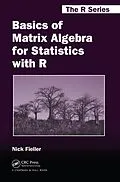A Thorough Guide to Elementary Matrix Algebra and Implementation in R
Basics of Matrix Algebra for Statistics with R provides a guide to elementary matrix algebra sufficient for undertaking specialized courses, such as multivariate data analysis and linear models. It also covers advanced topics, such as generalized inverses of singular and rectangular matrices and manipulation of partitioned matrices, for those who want to delve deeper into the subject.
The book introduces the definition of a matrix and the basic rules of addition, subtraction, multiplication, and inversion. Later topics include determinants, calculation of eigenvectors and eigenvalues, and differentiation of linear and quadratic forms with respect to vectors. The text explores how these concepts arise in statistical techniques, including principal component analysis, canonical correlation analysis, and linear modeling.
In addition to the algebraic manipulation of matrices, the book presents numerical examples that illustrate how to perform calculations by hand and using R. Many theoretical and numerical exercises of varying levels of difficulty aid readers in assessing their knowledge of the material. Outline solutions at the back of the book enable readers to verify the techniques required and obtain numerical answers.
Avoiding vector spaces and other advanced mathematics, this book shows how to manipulate matrices and perform numerical calculations in R. It prepares readers for higher-level and specialized studies in statistics.
Autorentext
Dr. Nick Fieller is a retired senior lecturer in the School of Mathematics and Statistics and an honorary research fellow in archaeology at the University of Sheffield. His research interests include multivariate data analysis and statistical modeling in the pharmaceutical industry, archaeology, and forensic sciences.
Inhalt
Introduction
Objectives
Further Reading
Guide to Notation
An Outline Guide to R
Inputting Data to R
Summary of Matrix Operators in R
Examples of R Commands
Vectors
Matrices
Matrix Arithmetic
Transpose and Trace of Sums and Products
Special Matrices
Partitioned Matrices
Algebraic Manipulation of matrices
Useful Tricks
Linear and Quadratic Forms
Creating Matrices in R
Matrix Arithmetic in R
Initial Statistical Applications
Rank of Matrices
Introduction and Definitions
Rank Factorization
Rank Inequalities
Rank in Statistics
Introduction and Definitions
Implementation in R
Properties of Determinants
Orthogonal Matrices
Determinants of Partitioned Matrices
A Key Property of Determinants
Inverses
Introduction and Definitions
Properties
Implementation in R
Inverses of Patterned Matrices
Inverses of Partitioned Matrices
General Formulae
Initial Applications Continued
Eigenanalysis of Real Symmetric Matrices
Introduction and Definitions
Eigenvectors
Implementation in R
Properties of Eigenanalyses
A Key Statistical Application: PCA
Matrix Exponential
Decompositions
Eigenanalysis of Matrices with Special Structures
Summary of Key Results
Vector and Matrix Calculus
Introduction
Differentiation of a Scalar with Respect to a Vector
Differentiation of a Scalar with Respect to a Matrix
Differentiation of a Vector with Respect to a Vector
Differentiation of a Matrix with Respect to a Scalar
Use of Eigenanalysis in Constrained Optimization
Further Topics
Introduction
Further Matrix Decompositions
Generalized Inverses
Hadamard Products
Kronecker Products and the Vec Operator
Key Applications to Statistics
Introduction
The Multivariate Normal Distribution
Principal Component Analysis
Linear Discriminant Analysis
Canonical Correlation Analysis
Classical Scaling
Linear Models
Outline Solutions to Exercises
Bibliography
Index
Exercises appear at the end of each chapter.
